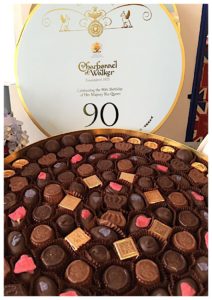18 September 2016
The Roaming Chocoholic is off to great adventures again, this time for work! First stop – the city best known for steins of beer, pretzels, schweinbraten (roast pork loin served with a beer sauce), weisswurst (white veal and pork sausage), sauerkraut and the world famous annual beer festival, Oktoberfest (that is in fact celebrated in September?).
Is there much more to Munich beyond beers and the hearty, savoury offerings described above? Perhaps a sweeter, chocolate-accented side? Here’s what I’ve discovered, during my second visit to this modern and lively city, in the heart of the German state of Bavaria.
Alcoholic Truffles
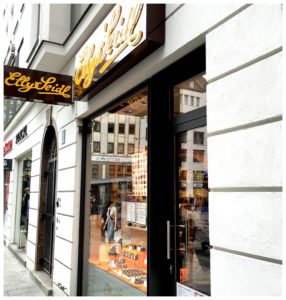 If you prefer to eat your alcohol, infused in chocolate truffles, look no further than Elly Siedl Pralinen. There are plenty to choose from, from traditional varieties like the Marc de champagne, rum, cognac and cointreau truffles to the more exotic pina colada and caipirinha truffles. For those who aren’t fans of the latter, Elly Seidl also has broad offerings of non-alcoholic truffles, ganaches, pralines, rochers and bars to suit differing tastes.
If you prefer to eat your alcohol, infused in chocolate truffles, look no further than Elly Siedl Pralinen. There are plenty to choose from, from traditional varieties like the Marc de champagne, rum, cognac and cointreau truffles to the more exotic pina colada and caipirinha truffles. For those who aren’t fans of the latter, Elly Seidl also has broad offerings of non-alcoholic truffles, ganaches, pralines, rochers and bars to suit differing tastes.
It’s easy to comprehend how this home-grown Bavarian chocolate establishment has existed for almost a century. It’s always busy! In the short time that I’m in the shop, located near the bustling Marienplatz, there is no less than a dozen customers streaming into the cozy retail space.
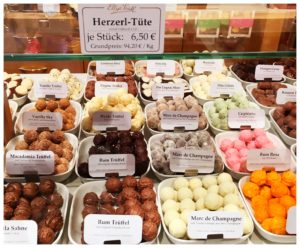 My top picks are the feminine pink Elly, a white chocolate heart with a pink centre, filled with raspberry liquor flavoured butter cream, and the Arrak teesahne, a crisp dark chocolate filled with Ceylon tea infused cream and flavoured with Arrak (Asian liquor made from fermented rice or palm syrup).
My top picks are the feminine pink Elly, a white chocolate heart with a pink centre, filled with raspberry liquor flavoured butter cream, and the Arrak teesahne, a crisp dark chocolate filled with Ceylon tea infused cream and flavoured with Arrak (Asian liquor made from fermented rice or palm syrup).
Ornate Marzipans and Nougats
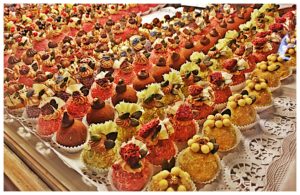 Fancy eating traditional treats of marzipan and nougat, turned into beautiful pieces of art that are lovingly handcrafted by its creator? Visit Sama-sama to experience first-hand Wilhelmine Raabe’s boundless creativity. Her marzipans and nougats are almost too pretty to eat, each decorated with miniature candied fruit, flowers and/ or nuts. She also makes a selection of truffles, with flavours such as butter, ginger and coffee, and tasty biscuits to indulge in.
Fancy eating traditional treats of marzipan and nougat, turned into beautiful pieces of art that are lovingly handcrafted by its creator? Visit Sama-sama to experience first-hand Wilhelmine Raabe’s boundless creativity. Her marzipans and nougats are almost too pretty to eat, each decorated with miniature candied fruit, flowers and/ or nuts. She also makes a selection of truffles, with flavours such as butter, ginger and coffee, and tasty biscuits to indulge in.
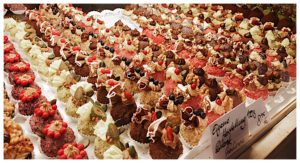 If you time your visit perfectly, you may catch Wilhelmine in action creating and decorating her marzipan and nougat masterpieces. There are apparently well over 100 variants, including the King Ludwig, the Venus Nipple, and the Hot, Chilli Seduction.
If you time your visit perfectly, you may catch Wilhelmine in action creating and decorating her marzipan and nougat masterpieces. There are apparently well over 100 variants, including the King Ludwig, the Venus Nipple, and the Hot, Chilli Seduction.
I’ve unfortunately forgotten the names of the chocolate nougat and blueberry marzipan that I sampled. I find them to be pleasant and flavourful, but a tad too sweet for me. I prefer the smooth and rich, butter flavoured dark chocolate truffle. The dark chocolate is intense and slightly bitter, with accents of butter.
Gourmet Chocolates
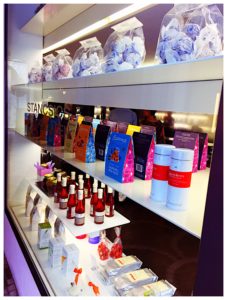 Fitting perfectly into its location, close to the glitzy shopping strip of Maximilianstrasse, is Stancsics Schoko Laden. The truffles, ganaches, pralines, marzipans, mandelsplitters (rochers) and bars have a classy French-Belgian flair about them, and are meticulously hand-made at the back of the shop.
Fitting perfectly into its location, close to the glitzy shopping strip of Maximilianstrasse, is Stancsics Schoko Laden. The truffles, ganaches, pralines, marzipans, mandelsplitters (rochers) and bars have a classy French-Belgian flair about them, and are meticulously hand-made at the back of the shop.
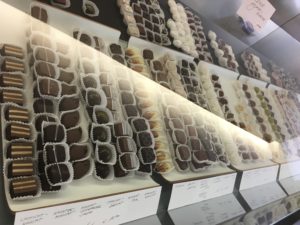 According to owner Silvia Stancsics, the main inspiration for her flavour creations comes from local and seasonal ingredients. Of course, meeting the taste preferences of her regular clientele is also important, which is why the variety spans alcoholic and non-alcoholic offerings. And with no added preservatives, the chocolates should be consumed within 6 to 8 days. You can also find offerings from other European chocolate makers here including the reputed Italian Domori, Austrian Tiroler Edle, Danish Summerbird and French Mademoiselle de Margaux.
According to owner Silvia Stancsics, the main inspiration for her flavour creations comes from local and seasonal ingredients. Of course, meeting the taste preferences of her regular clientele is also important, which is why the variety spans alcoholic and non-alcoholic offerings. And with no added preservatives, the chocolates should be consumed within 6 to 8 days. You can also find offerings from other European chocolate makers here including the reputed Italian Domori, Austrian Tiroler Edle, Danish Summerbird and French Mademoiselle de Margaux.
My recommendations are the balsamic vinegar ganache, a dark chocolate ganache flavoured with caramelised balsamic vinegar and coated in a thin, crisp dark chocolate shell, and the butter truffle, smooth, decadent butter cream coated in rich milk chocolate.
Beans for Health
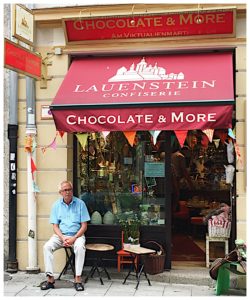 Christine Luger is an interior designer by trade, with a consuming passion for all things chocolate. It’s no surprise that she runs the hippy and inviting Chocolate & More – a shop, cafe and appreciation “school” all bundled in one, dedicated to chocolates.
Christine Luger is an interior designer by trade, with a consuming passion for all things chocolate. It’s no surprise that she runs the hippy and inviting Chocolate & More – a shop, cafe and appreciation “school” all bundled in one, dedicated to chocolates.
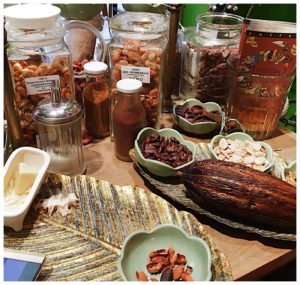 Christine is a strong advocate of the health promoting properties of raw cocoa beans. She tells me that consuming 3 whole beans a day is sufficient to meet our dietary intake of antioxidants, and offers me a tasting. I oblige and pop a raw Peruvian cacao bean into my mouth. It’s strong, nutty and definitely tastes like chocolate. Much better than medicine, to keep the lurgies at bay?
Christine is a strong advocate of the health promoting properties of raw cocoa beans. She tells me that consuming 3 whole beans a day is sufficient to meet our dietary intake of antioxidants, and offers me a tasting. I oblige and pop a raw Peruvian cacao bean into my mouth. It’s strong, nutty and definitely tastes like chocolate. Much better than medicine, to keep the lurgies at bay?
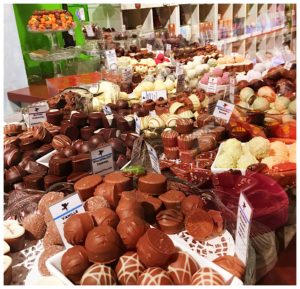 For those more inclined towards the chocolates, there’s a wide selection of truffles, pralines, ganaches, marzipans and bars from the northern Bavarian chocolate maker, Lauenstein. There are also chocolates and related products from neighboring countries such as France, Belgium and the UK. And the cafe specialises in hot chocolate, with contemporary concoctions like chilli and black pepper hot chocolate.
For those more inclined towards the chocolates, there’s a wide selection of truffles, pralines, ganaches, marzipans and bars from the northern Bavarian chocolate maker, Lauenstein. There are also chocolates and related products from neighboring countries such as France, Belgium and the UK. And the cafe specialises in hot chocolate, with contemporary concoctions like chilli and black pepper hot chocolate.
Pay Christine a visit, and her passion and enthusiasm for beans and chocolates will definitely rub off on you.
Global Chocolates Library
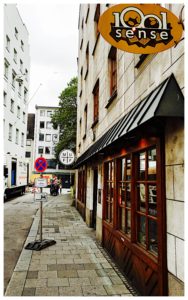 A global library of chocolates is how I can best describe 1001 Senses. They do not make their own but instead, showcase varieties throughout the world. Here, you will find prize winning, acclaimed chocolates from Akesson’s, Amedei, Ara, Domori, Francois Pralus, Marou, Valrhona, Michel Cluizel, Claudio Corallo and so much more.
A global library of chocolates is how I can best describe 1001 Senses. They do not make their own but instead, showcase varieties throughout the world. Here, you will find prize winning, acclaimed chocolates from Akesson’s, Amedei, Ara, Domori, Francois Pralus, Marou, Valrhona, Michel Cluizel, Claudio Corallo and so much more.
And Inna is a walking encyclopedia of these chocolates. She is so knowledgeable, passionate and ever willing to impart her wisdom. I could spend the whole day just listening to her speak about each chocolate manufacturer, their unique offerings, the origins of the cocoa beans and the breadth of flavours in the different variants.
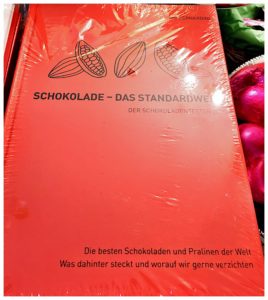 Inna recommends that I get myself a copy of the modern day chocolate encyclopaedia/ text book “Schokolade – Das Standardwerk: Der Schokoladetester 2015” (translates into Chocolate – The Standard Works: The Chocolate Tester 2015), by Georg Bernardini. Mental note to self………
Inna recommends that I get myself a copy of the modern day chocolate encyclopaedia/ text book “Schokolade – Das Standardwerk: Der Schokoladetester 2015” (translates into Chocolate – The Standard Works: The Chocolate Tester 2015), by Georg Bernardini. Mental note to self………
I ask to sample artisan German chocolates and she recommends the Georgia Ramon, made bean to bar by Georg Bernardini himself and his partner Ramona, and the Puristique range by Coppeneur et Compagnon. More on these in a separate post.
At the end of my adventures in Munich, I can safely conclude that the Bavarians have a degree of fondness and level of appreciation for chocolates too, although not as evident as their love for beers. So if you’re in Munich and find yourself in need of a chocolate fix, do pop into one of these establishments and you will not be disappointed!
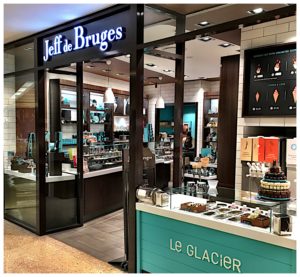 My first observation, as I approach the shop, is the decor. It’s fairly consistent around the world. For a moment, I forget where I am and imagine walking down a cobblestone street of a cosmopolitan European city, lapping up the late summer sun.
My first observation, as I approach the shop, is the decor. It’s fairly consistent around the world. For a moment, I forget where I am and imagine walking down a cobblestone street of a cosmopolitan European city, lapping up the late summer sun.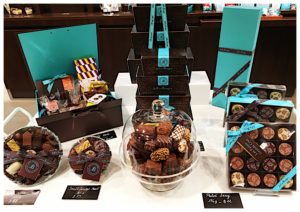 A lovely young lady welcomes me and asks if she can assist.
A lovely young lady welcomes me and asks if she can assist.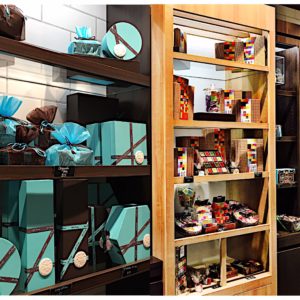 The shelves are adorned with attractive boxes of filled chocolates, as well as single origin bars and chocolate squares. No detail is spared with design and branding. The pocket sized catalogue of their filled chocolates and Juliettes (a version of the mendiant) is both a nice touch and handy to have, as I work my way through their selections.
The shelves are adorned with attractive boxes of filled chocolates, as well as single origin bars and chocolate squares. No detail is spared with design and branding. The pocket sized catalogue of their filled chocolates and Juliettes (a version of the mendiant) is both a nice touch and handy to have, as I work my way through their selections.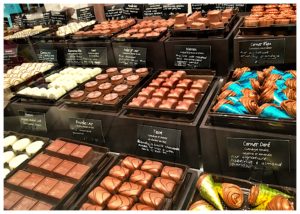 I’m offered a tasting of filled chocolates and pick the Maison de Jeff dark 70%. It’s a house-shaped dark chocolate praline with bits of almonds, and hints of cinnamon and coriander. The cinnamon is predictable in the combination and marries well with the dark chocolate and praline, but the coriander doesn’t come through for me. I find the Tarte Citron more exciting. The lemon is refreshing and balances both the sweetness and richness of the ganache, enveloped in dark chocolate. The Harvey is a play on textures, with an almost molten, creamy praline accented with bits of biscuit, in a dark chocolate shell shaped like a Scottish terrier. Almost too cute to eat.
I’m offered a tasting of filled chocolates and pick the Maison de Jeff dark 70%. It’s a house-shaped dark chocolate praline with bits of almonds, and hints of cinnamon and coriander. The cinnamon is predictable in the combination and marries well with the dark chocolate and praline, but the coriander doesn’t come through for me. I find the Tarte Citron more exciting. The lemon is refreshing and balances both the sweetness and richness of the ganache, enveloped in dark chocolate. The Harvey is a play on textures, with an almost molten, creamy praline accented with bits of biscuit, in a dark chocolate shell shaped like a Scottish terrier. Almost too cute to eat.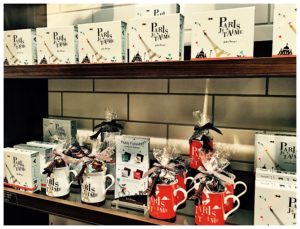 So, what’s the appeal of Jeff de Bruges chocolates? In my opinion, it’s the finer details – the attractive and perfectly shaped filled chocolates, the beautifully designed packaging of the boxed chocolates, bars and squares through to the broad variety to meet many a discerning tastes. I see the overall experience as a means to rekindle fond memories of European gastronomic adventures and perpetuate one’s holiday. The products are competitively priced against offerings from local renowned chocolatiers, which is an added bonus. The flavour combinations that I’ve tasted, while good, are not the most exciting that I’ve experienced in Sydney. However, I will reserve my final judgement as I’ve just been invited back for a tasting of Jeff de Bruges’ finest chocolates! I may also give the acclaimed ice cream a go, when the weather warms up.
So, what’s the appeal of Jeff de Bruges chocolates? In my opinion, it’s the finer details – the attractive and perfectly shaped filled chocolates, the beautifully designed packaging of the boxed chocolates, bars and squares through to the broad variety to meet many a discerning tastes. I see the overall experience as a means to rekindle fond memories of European gastronomic adventures and perpetuate one’s holiday. The products are competitively priced against offerings from local renowned chocolatiers, which is an added bonus. The flavour combinations that I’ve tasted, while good, are not the most exciting that I’ve experienced in Sydney. However, I will reserve my final judgement as I’ve just been invited back for a tasting of Jeff de Bruges’ finest chocolates! I may also give the acclaimed ice cream a go, when the weather warms up.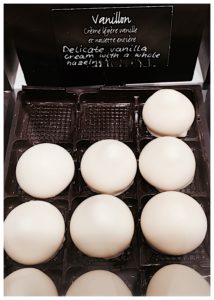 What is butter cream? As the name suggests, it’s chocolate containing a filling of butter and fresh cream, as well as milk and sugar. The ingredients are heated and mixed, then cooled and piped into moulded chocolate. Alternatively, the mixture is hardened through refrigeration, cut into shapes or shaped into balls, then enrobed in chocolate.
What is butter cream? As the name suggests, it’s chocolate containing a filling of butter and fresh cream, as well as milk and sugar. The ingredients are heated and mixed, then cooled and piped into moulded chocolate. Alternatively, the mixture is hardened through refrigeration, cut into shapes or shaped into balls, then enrobed in chocolate.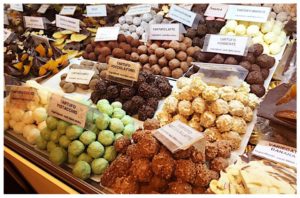
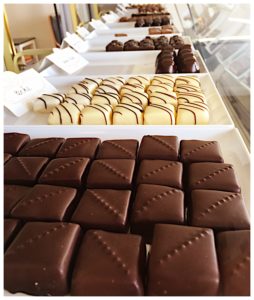
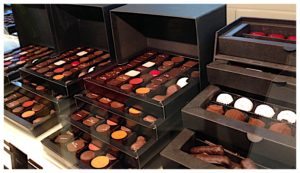 “Crunchy pralines are my favourite”, I tell Wanda. She explains that the traditional praline comprises almonds, usually crushed, coated with caramelised sugar and enrobed in chocolate. Crushed hazelnuts may sometimes be added.
“Crunchy pralines are my favourite”, I tell Wanda. She explains that the traditional praline comprises almonds, usually crushed, coated with caramelised sugar and enrobed in chocolate. Crushed hazelnuts may sometimes be added.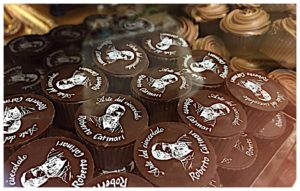 This chocolate originates from the Piedmont region of Italy, the home of Italian hazelnuts. As you’ve probably guessed, the gianduja is hazelnut-containing chocolate.
This chocolate originates from the Piedmont region of Italy, the home of Italian hazelnuts. As you’ve probably guessed, the gianduja is hazelnut-containing chocolate.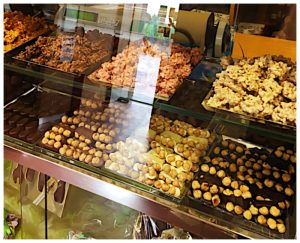 Rocher means rock, in French. In chocolate terms, it refers to slivers or whole pieces of nuts, usually almonds, coated in caramelised sugar, then dipped in chocolate and shaped into small rocks.
Rocher means rock, in French. In chocolate terms, it refers to slivers or whole pieces of nuts, usually almonds, coated in caramelised sugar, then dipped in chocolate and shaped into small rocks.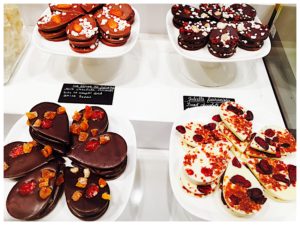 The mendiant has its historical origins in France. It’s the word for “beggar” in French and was originally created to represent the mendicant or religious figures who rely solely on the charity of others to survive.
The mendiant has its historical origins in France. It’s the word for “beggar” in French and was originally created to represent the mendicant or religious figures who rely solely on the charity of others to survive.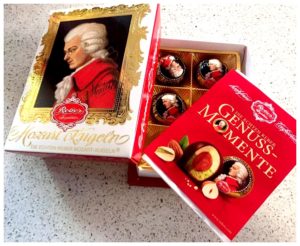
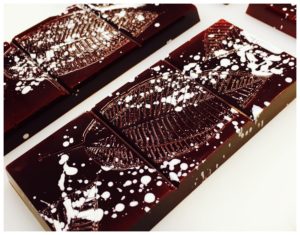 Perhaps the most ubiquitous and widely known of all chocolates, the bar or tablet is simply chocolate, set in a rectangular or square mould. The chocolate may be flavoured, ingredients like dried fruit and nuts may be added or it may be filled.
Perhaps the most ubiquitous and widely known of all chocolates, the bar or tablet is simply chocolate, set in a rectangular or square mould. The chocolate may be flavoured, ingredients like dried fruit and nuts may be added or it may be filled.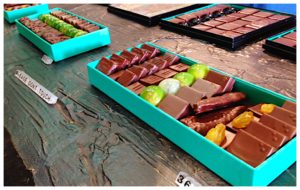 At the conclusion of the tour, we are grouped around the display of Patrick Roger’s masterful creations. Wanda points to different varieties of chocolates and asks us to name them, as a test of our knowledge. Suffice to say, we all pass with flying colours.
At the conclusion of the tour, we are grouped around the display of Patrick Roger’s masterful creations. Wanda points to different varieties of chocolates and asks us to name them, as a test of our knowledge. Suffice to say, we all pass with flying colours.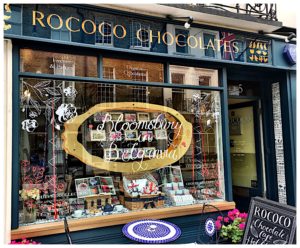 Our first stop takes us to the very well heeled district of Belgravia. The “older of the new”, established in the early 80s, Rococo is regarded as a pioneer of fine English chocolates. The shop exudes country charm. There’s a retail section out front, of shelves and a large glass counter brimming with chocolates, and a cozy cafe to the back, serving teas, hot chocolate and cakes. I’m immediately drawn to the hand-made beauties, in particular the painted sardines. Almost too beautiful to consume.
Our first stop takes us to the very well heeled district of Belgravia. The “older of the new”, established in the early 80s, Rococo is regarded as a pioneer of fine English chocolates. The shop exudes country charm. There’s a retail section out front, of shelves and a large glass counter brimming with chocolates, and a cozy cafe to the back, serving teas, hot chocolate and cakes. I’m immediately drawn to the hand-made beauties, in particular the painted sardines. Almost too beautiful to consume.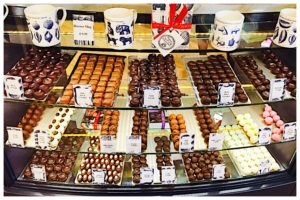 The kalamansi lime caramel grabs my interest and I give it a go. On the outside, it’s dark chocolate decorated with splashes of green cocoa butter. I take my first bite and my tastebuds are immediately shipped away to a tropical paradise. The shell, thin and well tempered, releases bursts of sweet and tangy kalamansi-infused caramel to create a refreshing taste sensation on the palate.
The kalamansi lime caramel grabs my interest and I give it a go. On the outside, it’s dark chocolate decorated with splashes of green cocoa butter. I take my first bite and my tastebuds are immediately shipped away to a tropical paradise. The shell, thin and well tempered, releases bursts of sweet and tangy kalamansi-infused caramel to create a refreshing taste sensation on the palate.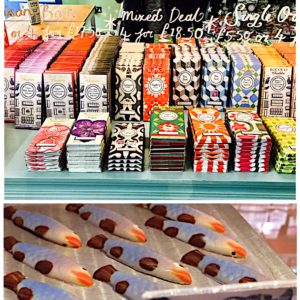
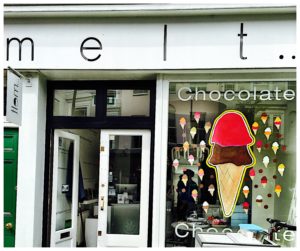 Next, we make our way to cosmopolitan and trendy Notting Hill, passing many a kebab shops and middle eastern eateries along the way, until we arrive at Melt. By London standards, Melt, can be considered a newcomer to the chocolate scene. The deco reflects this, with a contemporary and bright interior that oozes style and openness. From the entrance, I can see right through to the kitchen at the back, where their chocolates are meticulously hand-crafted. On this day, they are making caramel, which hubby and I have the pleasure of sampling. You can’t walk past the “Wall of Chocolate”, without pausing to examine it. It’s actually a plain shelf, but decorated with eye-catching, vibrant coloured chocolate bars of multiple varieties.
Next, we make our way to cosmopolitan and trendy Notting Hill, passing many a kebab shops and middle eastern eateries along the way, until we arrive at Melt. By London standards, Melt, can be considered a newcomer to the chocolate scene. The deco reflects this, with a contemporary and bright interior that oozes style and openness. From the entrance, I can see right through to the kitchen at the back, where their chocolates are meticulously hand-crafted. On this day, they are making caramel, which hubby and I have the pleasure of sampling. You can’t walk past the “Wall of Chocolate”, without pausing to examine it. It’s actually a plain shelf, but decorated with eye-catching, vibrant coloured chocolate bars of multiple varieties.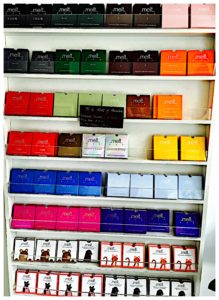 Hubby and I both hone in on the “Smoke” 64% dark chocolate bar. We ask to sample it and the lady serving us obliges. It has a toasty, earthy nose. As it melts on my tongue, the texture is smooth and velvety. I taste a hint of initial caramel, which gives way to more earthy flavours. Then, the ever so mild bitterness of charcoal, which lingers on the palate after all the chocolate has melted away. We read from the packaging that the bar is made from Criollo cocoa beans, grown in the volcanic islands of Sao Tome.
Hubby and I both hone in on the “Smoke” 64% dark chocolate bar. We ask to sample it and the lady serving us obliges. It has a toasty, earthy nose. As it melts on my tongue, the texture is smooth and velvety. I taste a hint of initial caramel, which gives way to more earthy flavours. Then, the ever so mild bitterness of charcoal, which lingers on the palate after all the chocolate has melted away. We read from the packaging that the bar is made from Criollo cocoa beans, grown in the volcanic islands of Sao Tome.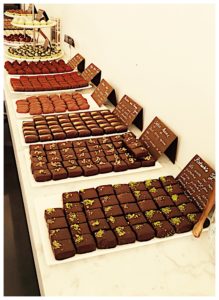 We follow through with the “Wild” 68% dark chocolate bar, named after the wild Bolivian criollo cocoa beans that have gone into its production. The nose is rather interesting – I smell bursts of chestnuts, interspersed with hints of mushroom. The texture on my tongue is even smoother than the “Smoke” bar. The taste brings back fond memories of Amedei. It starts with sweetened lemons, is quickly replaced by aniseed and finishes off with a lingering flavour that I can only describe as being that of mild flavoured mushrooms. The larger than bite size pralines and ganaches are also delectable. I recommend the textural pleasure of the salted praline cup and the fresh flavours of the passion and mango (gel) square.
We follow through with the “Wild” 68% dark chocolate bar, named after the wild Bolivian criollo cocoa beans that have gone into its production. The nose is rather interesting – I smell bursts of chestnuts, interspersed with hints of mushroom. The texture on my tongue is even smoother than the “Smoke” bar. The taste brings back fond memories of Amedei. It starts with sweetened lemons, is quickly replaced by aniseed and finishes off with a lingering flavour that I can only describe as being that of mild flavoured mushrooms. The larger than bite size pralines and ganaches are also delectable. I recommend the textural pleasure of the salted praline cup and the fresh flavours of the passion and mango (gel) square.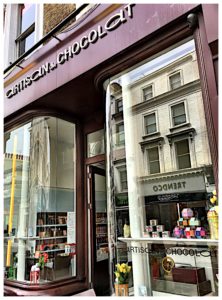 Still within Notting Hill is yet another renowned chocolate shop, famous for its No. 1 liquid sea salt caramels which were created for celebrity chef Gordon Ramsay. This is THE chocolate to try at Artisan du Chocolat. The gentleman serving us kindly offers us a sample, and we oblige. The taste is amazing – oozy, smooth caramel, sweet and lightly salted, enveloped in a rich, crisp dark chocolate shell and dusted with cocoa powder. Despite the French name, Irish born owner and chocolate maker Gerard Coleman actually honed his chocolate skills in London, after a training stint at Pierre Marcolini in Belgium.
Still within Notting Hill is yet another renowned chocolate shop, famous for its No. 1 liquid sea salt caramels which were created for celebrity chef Gordon Ramsay. This is THE chocolate to try at Artisan du Chocolat. The gentleman serving us kindly offers us a sample, and we oblige. The taste is amazing – oozy, smooth caramel, sweet and lightly salted, enveloped in a rich, crisp dark chocolate shell and dusted with cocoa powder. Despite the French name, Irish born owner and chocolate maker Gerard Coleman actually honed his chocolate skills in London, after a training stint at Pierre Marcolini in Belgium.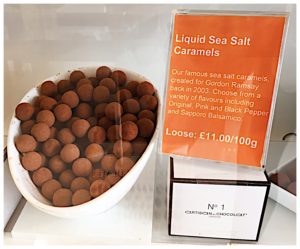 Apart from the sea salt caramels, there’s also a wide variety of indulgences to suit all tastes, from truffles, seasonal pralines and ganaches, through to specialty chocolates for those with specific dietary requirements. We are told that the chocolates are made from bean to bar, rather than using coverture.
Apart from the sea salt caramels, there’s also a wide variety of indulgences to suit all tastes, from truffles, seasonal pralines and ganaches, through to specialty chocolates for those with specific dietary requirements. We are told that the chocolates are made from bean to bar, rather than using coverture.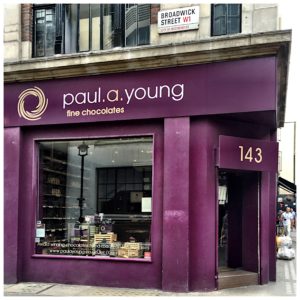 The last stop on this adventure is a visit to, in my opinion, perhaps the most bold and inventive of the lot. We head to the gentrified district of Soho, in search of multi award winning chocolatier, Paul A Young. You can’t miss the shop. It’s painted bright purple; perhaps the first glimpse into Paul’s personality? A large, round wooden table sits in the middle of the shop, and, on the day that we are there, the chocolates are presented on radially arranged trays.
The last stop on this adventure is a visit to, in my opinion, perhaps the most bold and inventive of the lot. We head to the gentrified district of Soho, in search of multi award winning chocolatier, Paul A Young. You can’t miss the shop. It’s painted bright purple; perhaps the first glimpse into Paul’s personality? A large, round wooden table sits in the middle of the shop, and, on the day that we are there, the chocolates are presented on radially arranged trays.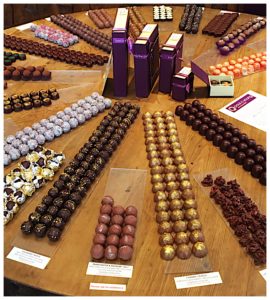 ancy a salted caramel or banoffee pie? Maybe a kalamansi truffle? Or peanut butter and raspberry jelly for those who enjoy the combination in a sandwich? There’s no end to the creativity and flavour combinations born from Paul’s imagination. I find the flavour combinations to be exciting and atypical, yet complimentary. Every selection is aesthetically pleasing; a true work of art. The sweetness levels, however, could be toned down a little.
ancy a salted caramel or banoffee pie? Maybe a kalamansi truffle? Or peanut butter and raspberry jelly for those who enjoy the combination in a sandwich? There’s no end to the creativity and flavour combinations born from Paul’s imagination. I find the flavour combinations to be exciting and atypical, yet complimentary. Every selection is aesthetically pleasing; a true work of art. The sweetness levels, however, could be toned down a little.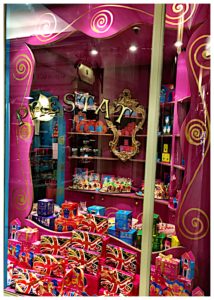 Our first stop looks like something out of Willy Wonka’s Chocolate Factory. In fact, I hear that it is THE inspiration for Roald Dahl’s Charlie and the Chocolate Factory. With its vibrant coloured displays and floor to ceiling selections in multi-shaped boxes, Prestat is a sure hit with kids and the young at heart. Like the character Augustus Gloop, I too am overwhelmed by the temptation to over-indulge in this magical chocolate shop.
Our first stop looks like something out of Willy Wonka’s Chocolate Factory. In fact, I hear that it is THE inspiration for Roald Dahl’s Charlie and the Chocolate Factory. With its vibrant coloured displays and floor to ceiling selections in multi-shaped boxes, Prestat is a sure hit with kids and the young at heart. Like the character Augustus Gloop, I too am overwhelmed by the temptation to over-indulge in this magical chocolate shop.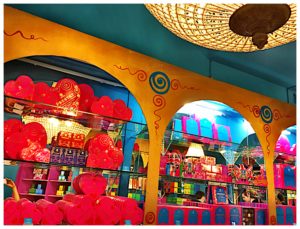 There are truffles and pralines abound in the glass display counter, and chocolate bars of various sizes and flavours sitting atop it. Help is at hand as the gentleman behind the counter steers me to the yuzu sake and red velvet truffles, apparently the latest crowd pleasers.
There are truffles and pralines abound in the glass display counter, and chocolate bars of various sizes and flavours sitting atop it. Help is at hand as the gentleman behind the counter steers me to the yuzu sake and red velvet truffles, apparently the latest crowd pleasers.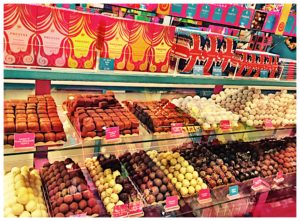 The yuzu sake truffle is refreshing. The tartness of the white chocolate yuzu ganache does wonders to complement the sweetness of the dark chocolate shell that envelops it. I am reminded of lemon sherbets, minus the fizzle. The sake is so subtle that it’s hardly discernible. As far as first impressions go, the red velvet truffle is attractive. It’s an inside out version of the traditional namesake. Dark pink, rounded beauties dusted with raspberry powder on the outside, icing on the inside and a milk chocolate shell in the middle. Top marks for creativity. As for the taste, I find it to be a tad too sweet for my liking. The tartness of the raspberry powder works to some extent to counter this, but the milk chocolate and icing combination tips the sugar scales in a truffle. Maybe dark chocolate could have worked better?
The yuzu sake truffle is refreshing. The tartness of the white chocolate yuzu ganache does wonders to complement the sweetness of the dark chocolate shell that envelops it. I am reminded of lemon sherbets, minus the fizzle. The sake is so subtle that it’s hardly discernible. As far as first impressions go, the red velvet truffle is attractive. It’s an inside out version of the traditional namesake. Dark pink, rounded beauties dusted with raspberry powder on the outside, icing on the inside and a milk chocolate shell in the middle. Top marks for creativity. As for the taste, I find it to be a tad too sweet for my liking. The tartness of the raspberry powder works to some extent to counter this, but the milk chocolate and icing combination tips the sugar scales in a truffle. Maybe dark chocolate could have worked better?
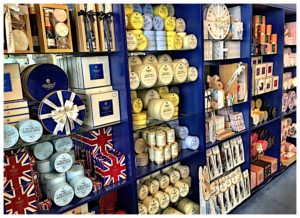 Drawing similarities with The Queen, Charbonnel et Walker is an English institution in itself, established back in 1875. Initially formed as a partnership between Mrs Walker and Madame Charbonnel, from an esteemed chocolate house in Paris, the chocolate shop has stood the test of time and maintains its Parisian chic to this day. Plus the chocolates are still meticulously handmade to traditional, age old recipes.
Drawing similarities with The Queen, Charbonnel et Walker is an English institution in itself, established back in 1875. Initially formed as a partnership between Mrs Walker and Madame Charbonnel, from an esteemed chocolate house in Paris, the chocolate shop has stood the test of time and maintains its Parisian chic to this day. Plus the chocolates are still meticulously handmade to traditional, age old recipes.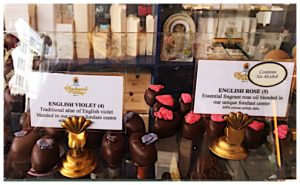 We hone in on the English violet cream, and its sister variety, the English rose cream. Both are dainty and oval shaped, with violet and rose infused fondants respectively, enrobed in dark chocolate. A small sliver of candied violet or rose petal adorns the top of each piece. The dark chocolate is velvety smooth but I find the floral infused fondants to be a tad too sweet. We are recommended the more contemporary dark sea salt caramel truffle and the traditional strawberry truffle. Both are esthetically pleasing, but, again, too sweet for my liking.
We hone in on the English violet cream, and its sister variety, the English rose cream. Both are dainty and oval shaped, with violet and rose infused fondants respectively, enrobed in dark chocolate. A small sliver of candied violet or rose petal adorns the top of each piece. The dark chocolate is velvety smooth but I find the floral infused fondants to be a tad too sweet. We are recommended the more contemporary dark sea salt caramel truffle and the traditional strawberry truffle. Both are esthetically pleasing, but, again, too sweet for my liking.